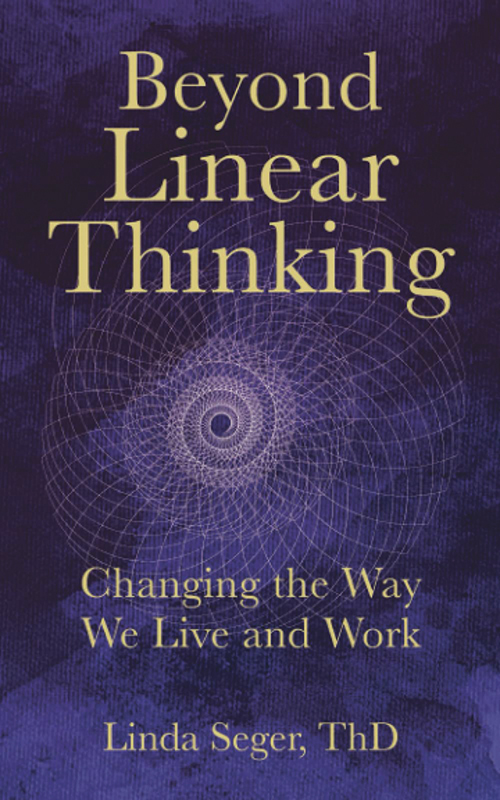
Beyond Linear Thinking: Changing the Way We Live and Work (Third Edition)
Reviewed by Carl Blumenthal
June 1, 2023
By Linda Seger. Red Typewriter Press, 2022. 263 pages. $12.99/paperback; $7.99/eBook.
An interview with Linda Seger is included in the July 2023 podcastWhether or not you liked geometry in school, Friend Linda Seger insists that the line, circle, spiral, and web are images that represent the possibilities for how we can interact with each other. This progression from the one-dimensional line to the multidimensional web is the wave of the future in secular and spiritual relations.
The line or linear thinking means the dog-eat-dog world of work and the marketplace, where hierarchy, materialism, and selfishness prevail. The circle is more inclusive and cooperative, with team effort and the common good being more important than any one member getting ahead. (Think of The Dot and the Line: A Romance in Lower Mathematics by Norton Juster, “later made into a charming little film.”) Seger worked in the cutthroat film industry as a screenwriter and screenwriting coach, from which she takes many of her lessons. Obtaining a divinity degree aided her transformation into a web thinker.
The spiral is a more sophisticated, three-dimensional version of the line. Here the focus is on an individual’s struggles to find balance between existential ups and downs. (Think of the Sufi whirling dervishes or a labyrinth.) On the other hand, the web of social relations allows a person to integrate both their inner and outer selves, while cultivating connection with other supporters of humanity on a global as well as a local level. (Think of a spider’s web or the World Wide Web.)
First published in 2002 as Web Thinking: Connecting, Not Competing for Success, this third edition, while mentioning digital networking during the COVID pandemic, does not explore the seismic implications of many people living and working in isolation at home. Perhaps that is too tall an order, as those effects are still playing out before our eyes, but it still feels like a missed opportunity to make this valuable approach more relevant to our time.
Seger draws on her membership in Santa Monica (Calif.) Meeting for inspiration—especially the sought-after unity of business meetings and clearness committees. (She now lives in Colorado and attends Portland (Maine) Meeting via Zoom.) Partly due to this background, the book seems more suited to middle-class readers like her and me, many of whom had the luxury of remote-friendly jobs compared to frontline workers who were expected to sacrifice their health and safety during the initial lockdown.
And it’s within this context that I found a way to apply Seger’s framework to my own life and work. During the pandemic, I followed a leading to come out of retirement as a mental health peer counselor and serve my fellow New Yorkers by working remotely for the city’s crisis line. As someone who has experienced depression—I have lived with bipolar disorder for 50 years—I felt a desire to connect with and support my peers living with mental health and substance use challenges.
While reading Beyond Linear Thinking, I made the following observation: While the web is supposed to integrate the three other forms of circle, spiral, and line, Seger’s clearly linear presentation of them in four consecutive chapters implies that the four phases of social relations are, ironically, a progression. And you know where her preferences lie because the circle and web chapters are twice as long as those about the line and the spiral.
Yet I discovered that only by combining all of them could I be most helpful as a peer counselor. In a nonprofit with 750 employees where I was a “line worker,” I had to play political games diplomatically (linear thinking), engage coworkers cooperatively (circular thinking), integrate my inner and outer selves to be fully present for our clients (spiral thinking), and network with colleagues outside my agency to optimize our effectiveness (web thinking). More recently I’ve taken steps to advance my career from the linear and circular stages to those of spiral and web thinking.
Seger doesn’t shy away from describing the pitfalls of each of the four stages, but she doesn’t delve into how misinformation on social media can be deadly. She is at her best when she uses anecdotes from her own life to illustrate the four stages, such as successful web responses to a failed speaking engagement and to a developer threatening to destroy her town’s watershed.
This interdisciplinary book also draws on wisdom from thought leaders in such fields as “science, history, archaeology, business, aviation, the military, the arts, and theology.” The bibliography alone is worth the purchase price.
Although Linda Seger sometimes generalizes without clear examples, Beyond Linear Thinking is hugely enlightening and entertaining. What else would you expect from the author of When Women Call the Shots: The Developing Power and Influence of Women in Television and Film!
Carl Blumenthal is a member of Brooklyn (N.Y.) Meeting and a former arts reporter with the Brooklyn Daily Eagle.
1 thought on “Beyond Linear Thinking: Changing the Way We Live and Work (Third Edition)”
Leave a Reply
Comments on Friendsjournal.org may be used in the Forum of the print magazine and may be edited for length and clarity.



Emotion can overcome thinking.